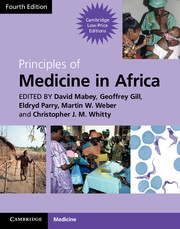Book contents
- Frontmatter
- Contents
- Contributors
- Foreword
- Section 1 Health and disease
- Section 2 Mother and child health
- Section 3 Infection: general principles
- Section 4 Major common infections
- Section 5 Bacterial infections
- Section 6 Viral Infections
- Section 7 Protozoal infections
- Section 8 Helminth infections
- Section 9 Fungal infections
- Section 10 Non-communicable diseases
- Section 11 Diseases of body systems
- 65 The heart
- 66 The lung
- 67 Blood disorders
- 68 The gut
- 69 The liver
- 70 The kidney and body fluids
- 71 Bones and joints
- 72 Endocrinology
- 73 The nervous system
- 74 The skin
- 75 The eye
- Section 12 Cancer and Palliative Care
- Section 13 Venoms and Poisons
- Index
- References
73 - The nervous system
from Section 11 - Diseases of body systems
Published online by Cambridge University Press: 05 March 2013
- Frontmatter
- Contents
- Contributors
- Foreword
- Section 1 Health and disease
- Section 2 Mother and child health
- Section 3 Infection: general principles
- Section 4 Major common infections
- Section 5 Bacterial infections
- Section 6 Viral Infections
- Section 7 Protozoal infections
- Section 8 Helminth infections
- Section 9 Fungal infections
- Section 10 Non-communicable diseases
- Section 11 Diseases of body systems
- 65 The heart
- 66 The lung
- 67 Blood disorders
- 68 The gut
- 69 The liver
- 70 The kidney and body fluids
- 71 Bones and joints
- 72 Endocrinology
- 73 The nervous system
- 74 The skin
- 75 The eye
- Section 12 Cancer and Palliative Care
- Section 13 Venoms and Poisons
- Index
- References
Summary
The problem in Africa
In Africa the spectrum of neurological disease is in many ways similar to other parts of the world, but significant differences are obvious. Relative to industrialized countries, stroke and epilepsy are very common, but dementia or Parkinson's disease are much less so, at least at present. Which of the particular geographical, climatic, social and ethnic factors of the continent govern the pattern of disease? Why is multiple sclerosis almost unknown in tropical Africa, whereas defined local factors account for tropical ataxic neuropathy? While the epidemic of HIV infection is bringing its own range of neurological complications, there are few local data about Parkinson's disease, or even stroke. A comment made about tropical neurology by Spillane in 1973, is still true of Africa, ‘ . . . the repeated assertion that many diseases of the nervous system are uncommon or actually rare in certain tropical zones is a premature generalization . . . We are nowhere near a position to make any broad and confident generalization about the distribution of diseases of the nervous system in the tropics’.
Epidemiological work in Africa is demanding, but some careful studies have provided valuable data, as the early example from Ethiopia demonstrates (Table 73.1). Researchers are actively building a more comprehensive picture, but the lack of neurological resource is a constant obstruction to development, and to basic assessment and treatment of neurological problems (WHO, 2004).
- Type
- Chapter
- Information
- Principles of Medicine in Africa , pp. 746 - 778Publisher: Cambridge University PressPrint publication year: 2013



